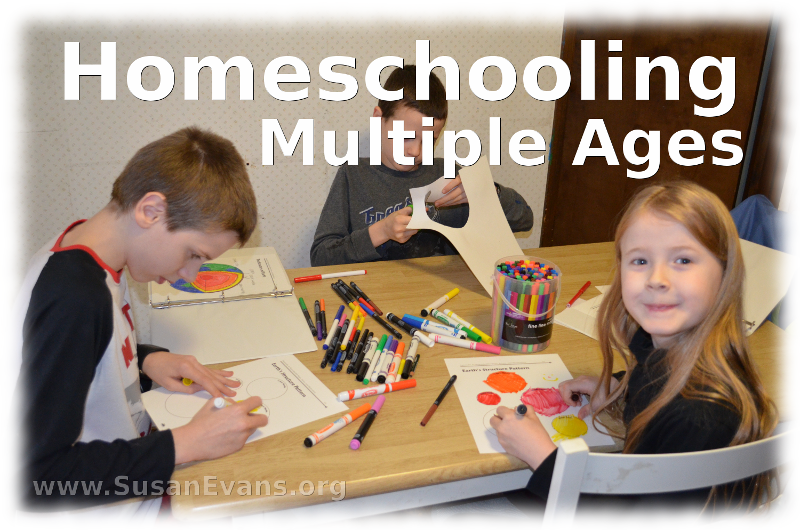How do you homeschool multiple ages? Here is a webinar that describes what you can do when you are homeschooling multiple ages:
Is it possible to teach children of all ages at the same time? How do you modify assignments for different ages?
With unit studies, you can easily teach your children of multiple ages. This applies to history, science, literature, geography, and even writing. One time my kids were making a homemade botany field guide. A young child who could barely form his letters wrote the name of the plant under the cut-out magazine picture for each page. A slightly older child wrote one sentence under each plant picture. An older child wrote a full paragraph about the plant, using botanical terms that we had learned. So each child was able to complete the writing assignment on his or her level, and yet we were all studying the same topic.
I did a series on my blog about unit studies, where I explain how to teach all of your students at the same time, cutting down on the amount of teaching time for you and fostering family unity. You can find the 5-day unit studies series here: Unit Studies 101.
How do you keep babies and toddlers busy while teaching older children?
You can keep younger children occupied with age-appropriate activities at the table where you are working with your other students. If you can give them something that can keep their hands busy and keep them from interrupting your teaching, this is what you want. Here are some open-ended ideas for preschoolers: wooden puzzles, lacing cards, Play Doh, paint-with-water, coloring books, interlocking beads, tangrams, etc.
Another method that worked for keeping preschoolers occupied while teaching older kids was a fenced area with a CD with either my voice or classical music, or an educational CD. Hearing the mother or father’s voices or familiar songs can be comforting to babies and toddlers, and they are more likely to be quiet and listen. My toddlers and preschoolers were able to play quietly on their own for longer periods of time using this method. I always put open-ended toys in the room so that my kids could play for a while, not just for five minutes. If you need more ideas on how to keep babies and toddlers occupied while teaching older kids, watch the free webinar A Routine for Young Children.
How does organizing your time help you to get all your homeschooling done with children of different ages?
You do need to sit down and decide how you want to structure your day if you want to homeschool with success. At minimum you need some sort of routine where you begin the day with math, for example, and then move on to your unit study. If you are doing 4 or 5 subjects in your homeschool, it’s easier if you plan ahead of time which order you will be covering the subjects so that your students can develop a natural rhythm to their day. This makes the day run more smoothly and enables your students to get everything done.
If you need help with organizing your day, you can take a look at my articles and videos about Homeschool Organization. You can also sign up for a free Homeschool Room Makeover video workshop, which will help you to feel more organized in your homeschool.
Tags: family, family unity, Homeschooling




That’s a question I used to get from a lot of people when I was homeschooling 4 or 5 kids. It’s doable. Homeschool moms are super heros, after all! 😉
Behold our capes flying behind our backs…
I used to be so scared of the time when all of mine were “school age”. Now, I think it is much easier to teach them as a group then independently. Great post!
Yes, it’s much easier to teach your kids as a group rather than separately!